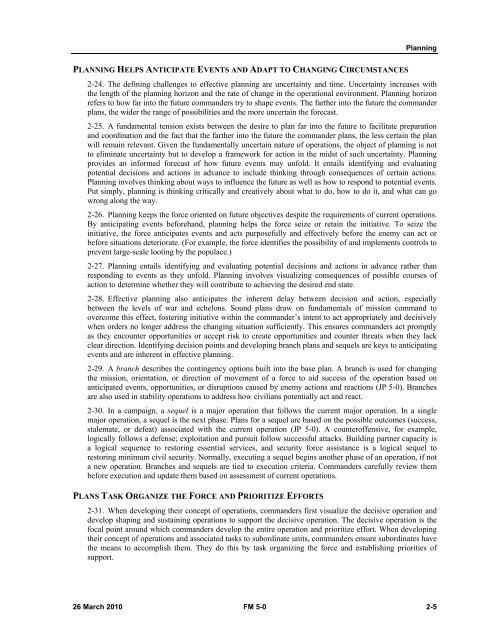FM 5-0, The Operations Process - Federation of American Scientists
FM 5-0, The Operations Process - Federation of American Scientists
FM 5-0, The Operations Process - Federation of American Scientists
Create successful ePaper yourself
Turn your PDF publications into a flip-book with our unique Google optimized e-Paper software.
Planning<br />
PLANNING HELPS ANTICIPATE EVENTS AND ADAPT TO CHANGING CIRCUMSTANCES<br />
2-24. <strong>The</strong> defining challenges to effective planning are uncertainty and time. Uncertainty increases with<br />
the length <strong>of</strong> the planning horizon and the rate <strong>of</strong> change in the operational environment. Planning horizon<br />
refers to how far into the future commanders try to shape events. <strong>The</strong> farther into the future the commander<br />
plans, the wider the range <strong>of</strong> possibilities and the more uncertain the forecast.<br />
2-25. A fundamental tension exists between the desire to plan far into the future to facilitate preparation<br />
and coordination and the fact that the farther into the future the commander plans, the less certain the plan<br />
will remain relevant. Given the fundamentally uncertain nature <strong>of</strong> operations, the object <strong>of</strong> planning is not<br />
to eliminate uncertainty but to develop a framework for action in the midst <strong>of</strong> such uncertainty. Planning<br />
provides an informed forecast <strong>of</strong> how future events may unfold. It entails identifying and evaluating<br />
potential decisions and actions in advance to include thinking through consequences <strong>of</strong> certain actions.<br />
Planning involves thinking about ways to influence the future as well as how to respond to potential events.<br />
Put simply, planning is thinking critically and creatively about what to do, how to do it, and what can go<br />
wrong along the way.<br />
2-26. Planning keeps the force oriented on future objectives despite the requirements <strong>of</strong> current operations.<br />
By anticipating events beforehand, planning helps the force seize or retain the initiative. To seize the<br />
initiative, the force anticipates events and acts purposefully and effectively before the enemy can act or<br />
before situations deteriorate. (For example, the force identifies the possibility <strong>of</strong> and implements controls to<br />
prevent large-scale looting by the populace.)<br />
2-27. Planning entails identifying and evaluating potential decisions and actions in advance rather than<br />
responding to events as they unfold. Planning involves visualizing consequences <strong>of</strong> possible courses <strong>of</strong><br />
action to determine whether they will contribute to achieving the desired end state.<br />
2-28. Effective planning also anticipates the inherent delay between decision and action, especially<br />
between the levels <strong>of</strong> war and echelons. Sound plans draw on fundamentals <strong>of</strong> mission command to<br />
overcome this effect, fostering initiative within the commander’s intent to act appropriately and decisively<br />
when orders no longer address the changing situation sufficiently. This ensures commanders act promptly<br />
as they encounter opportunities or accept risk to create opportunities and counter threats when they lack<br />
clear direction. Identifying decision points and developing branch plans and sequels are keys to anticipating<br />
events and are inherent in effective planning.<br />
2-29. A branch describes the contingency options built into the base plan. A branch is used for changing<br />
the mission, orientation, or direction <strong>of</strong> movement <strong>of</strong> a force to aid success <strong>of</strong> the operation based on<br />
anticipated events, opportunities, or disruptions caused by enemy actions and reactions (JP 5-0). Branches<br />
are also used in stability operations to address how civilians potentially act and react.<br />
2-30. In a campaign, a sequel is a major operation that follows the current major operation. In a single<br />
major operation, a sequel is the next phase. Plans for a sequel are based on the possible outcomes (success,<br />
stalemate, or defeat) associated with the current operation (JP 5-0). A counter<strong>of</strong>fensive, for example,<br />
logically follows a defense; exploitation and pursuit follow successful attacks. Building partner capacity is<br />
a logical sequence to restoring essential services, and security force assistance is a logical sequel to<br />
restoring minimum civil security. Normally, executing a sequel begins another phase <strong>of</strong> an operation, if not<br />
a new operation. Branches and sequels are tied to execution criteria. Commanders carefully review them<br />
before execution and update them based on assessment <strong>of</strong> current operations.<br />
PLANS TASK ORGANIZE THE FORCE AND PRIORITIZE EFFORTS<br />
2-31. When developing their concept <strong>of</strong> operations, commanders first visualize the decisive operation and<br />
develop shaping and sustaining operations to support the decisive operation. <strong>The</strong> decisive operation is the<br />
focal point around which commanders develop the entire operation and prioritize effort. When developing<br />
their concept <strong>of</strong> operations and associated tasks to subordinate units, commanders ensure subordinates have<br />
the means to accomplish them. <strong>The</strong>y do this by task organizing the force and establishing priorities <strong>of</strong><br />
support.<br />
26 March 2010 <strong>FM</strong> 5-0 2-5















